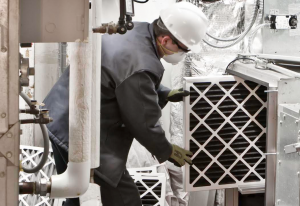
What is Sick Building Syndrome?
According to the Centers for Disease Control and Prevention (CDC), the average American spends 90% of their time indoors, which is one reason indoor air quality (IAQ) has been identified as one of the top five most urgent environmental risks to public health by the Environmental Protection Agency (EPA).
Poor indoor air quality can be harmful to building occupants and actually cause flu-like symptoms, such as headaches, sinus problems, congestion, dizziness, nausea, fatigue and irritation of the eyes, nose or throat. This is known as Sick Building Syndrome: situations in which building occupants experience acute health and comfort issues that appear to be linked to time spent in a building.
Your Commercial Building Is Due for a Checkup
Buildings have two lines of defense: its thermal envelope and its air handling units. The thermal envelope is designed to keep thermal comfort heating and cooling in, while simultaneously keeping outside air and contaminates out. The air handling units, meanwhile, introduce the regulatory required amount of outside fresh air into the building.
Want to know how your building is performing and how it rates? A review of your facility’s outdoor air intake (a ventilation safety audit), along with ventilation system recommissioning, is the best way to determine the health of your building and the potential for contaminated air coming into your building.
How to Improve Indoor Air Quality
There are two ways to stop airborne contaminants from entering your building and reaching your air handing units.
- Filtration: Enhanced particle filtration can help to eliminate potentially harmful pollutants. Use the Minimum Efficiency Reporting Value (MERV) rating system or the High-Efficiency Particulate Air (HEPA) when selecting your filters.
- Air Cleaning: Sorbent-based gaseous air cleaning, ultraviolet germicidal irradiation, or photocatalytic oxidative air cleaning, combined with filtration, helps create a barrier from airborne dangers.
Improve Indoor Air Quality with Preventative HVAC Maintenance
As part of our integrated facilities services and on-site engineering services, Crockett Facilities Services, Inc. (CFSI) ensures safe and healthy indoor air quality, along with energy-saving practices from heating and air conditioning preventative maintenance. As a leading mechanical contractor with mobile 24/7 commercial HVAC service throughout Virginia, Maryland, and Washington, DC, we help property managers and building owners meet their financial goals, while keeping occupants comfortable and happy.
Contact us for an HVAC preventive maintenance proposal!
We’re here to help with 2015 budget planning.
To learn more about Indoor Air Quality or Ventilation Recommissioning, please contact CFSI at 202.600.2787 or sales@crockett-facilities.com. Even if you have an in-house maintenance or engineering team, we can supplement your maintenance needs with our comprehensive heating, ventilation, and cooling (HVAC), custodial, energy management and data center cooling services.
Like us on Facebook; follow us on LinkedIn, Twitter, and Google+.
Sources:
Your Building’s Immune System 101 — From Anthrax to Ebola, Facilities Engineering Journal
